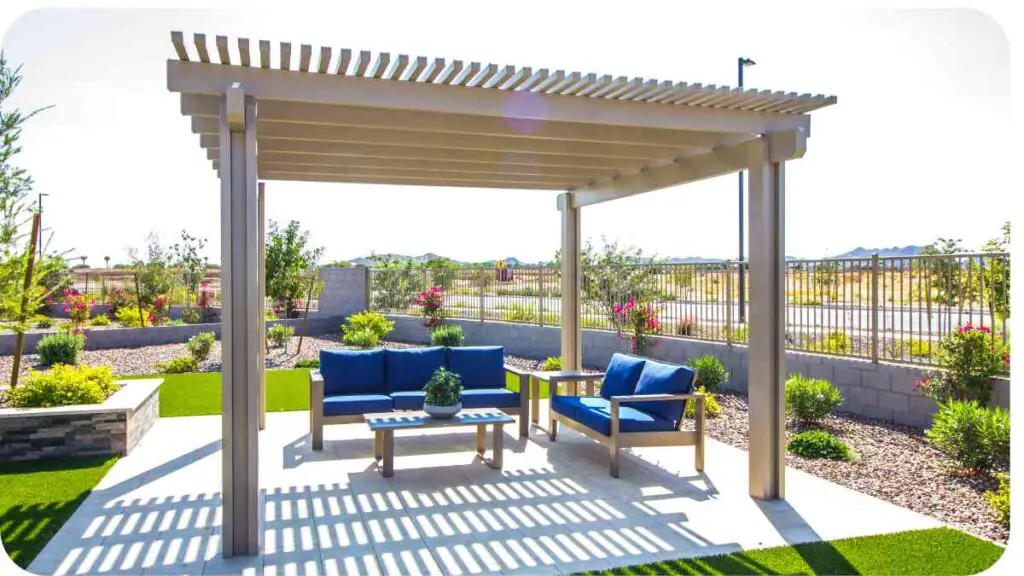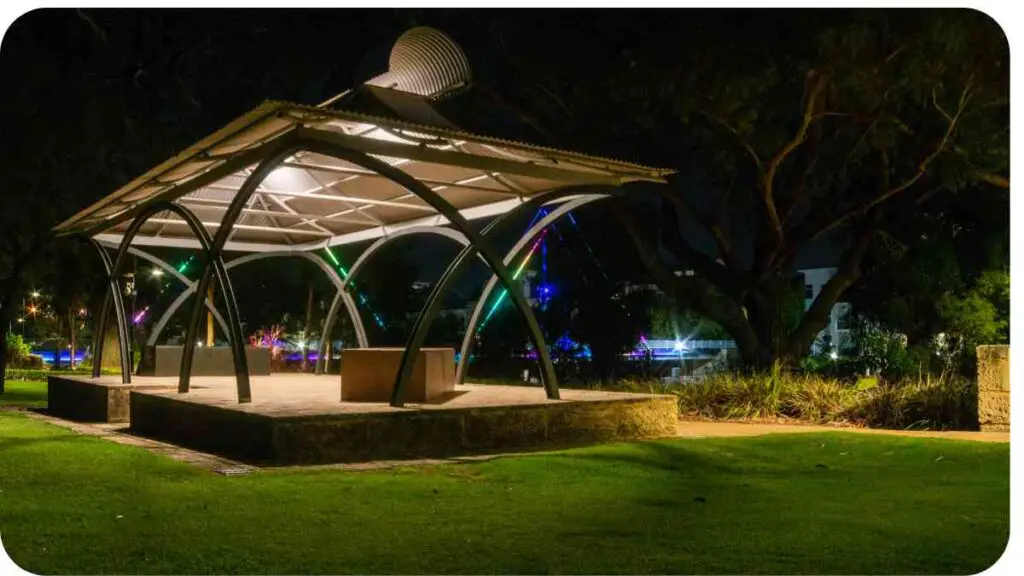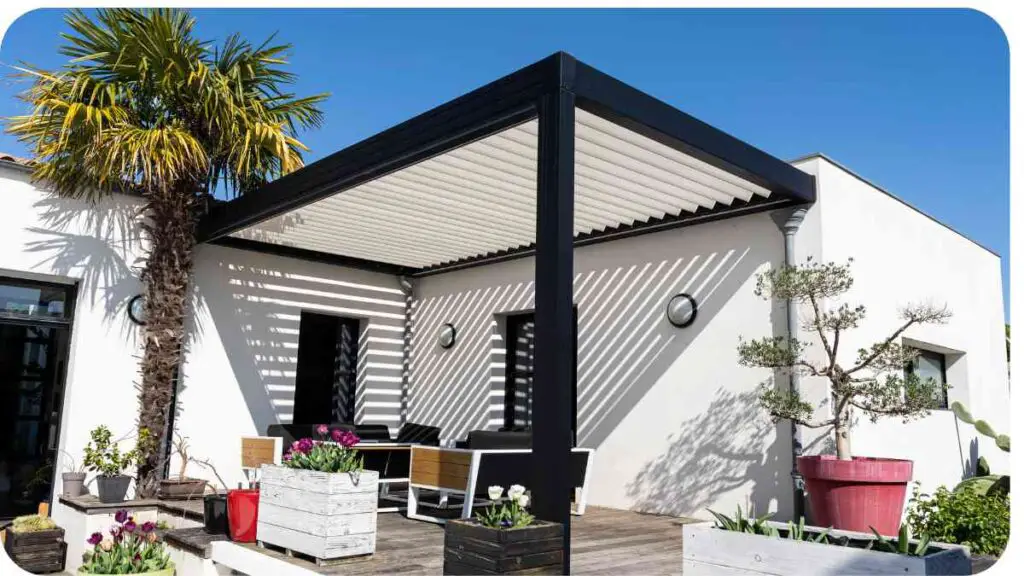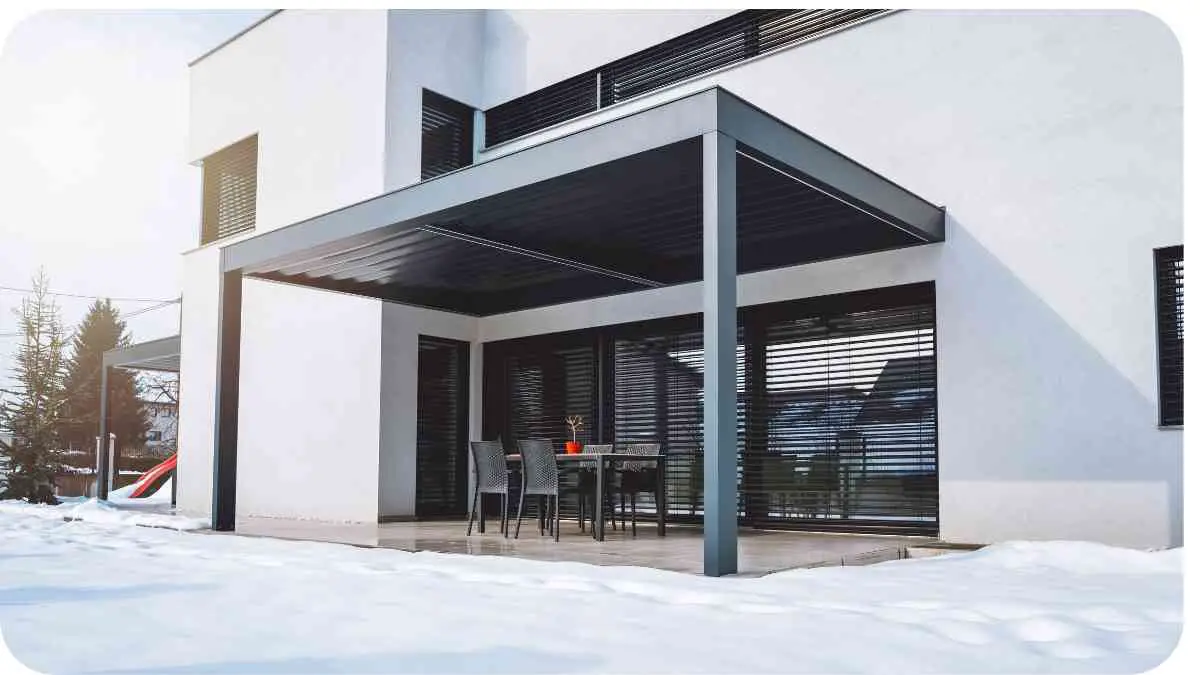When it comes to designing outdoor spaces, versatility and style often top the list of priorities. Retractable roofs offer a perfect blend of both, making them a fantastic choice for anyone looking to enhance their pergola or patio.
Imagine a setup that adapts to weather conditions with just the push of a button or a gentle pull on a rope. Sounds ideal, right? Let’s dive into the world of retractable roofs and explore how they can transform your outdoor living experience.
| Key Takeaways |
|---|
| Retractable roofs offer versatility, adapting to any weather with ease. |
| They provide protection from sun, rain, and wind, enhancing outdoor comfort. |
| Available in manual and motorized options, each with unique benefits. |
| Materials include fabric, aluminum, and polycarbonate, each with specific pros and cons. |
| Considerations for choosing a retractable roof include space, climate, and budget. |
| Design options range from modern to traditional, fitting various aesthetic preferences. |
| Installation involves measuring, choosing materials, and mounting tracks. |
| Regular maintenance includes cleaning and checking for damage. |
| Case studies show successful use in both residential and commercial settings. |
| Retractable roofs typically last 10-15 years with proper care. |
What Are Retractable Roofs?
Definition
Retractable roofs are a type of roofing system that can be opened or closed as needed. They are commonly used in pergolas, patios, and other outdoor spaces to provide shelter from the sun, rain, or wind. These roofs can be made from various materials and can be operated manually or automatically.
Exploring various pergola styles can transform your outdoor space from mundane to magnificent. Whether you’re interested in rustic to modern pergola styles, each design offers unique benefits that can enhance both the aesthetic and functionality of your home garden.
How They Work
Retractable roofs use a system of tracks, motors, and fabric or other materials to move the roof cover. When the roof is closed, it offers protection from the elements. When open, it allows you to enjoy the outdoors. Think of it as a giant, sophisticated umbrella that covers your entire patio!
Benefits of Retractable Roofs

Adaptability
One of the biggest advantages of retractable roofs is their adaptability. Whether it’s a sunny afternoon or a rainy evening, you can adjust the roof to suit your needs. This flexibility makes them ideal for all seasons and weather conditions.
Protection from Elements
Retractable roofs provide excellent protection from the sun, rain, and wind. On hot summer days, you can extend the roof to create shade. During a light rain, you can keep the roof closed to stay dry. It’s like having your own personal weather control system!
Aesthetic Appeal
Beyond their functional benefits, retractable roofs also enhance the aesthetic appeal of your space. They come in various styles and materials, allowing you to choose one that complements your existing decor. Whether you prefer a sleek modern look or a more traditional design, there’s a retractable roof to match.
Types of Retractable Roofs

Manual vs. Motorized
Retractable roofs can be operated manually or motorized. Manual systems require you to pull a cord or handle to open or close the roof. Motorized systems, on the other hand, use an electric motor controlled by a remote or wall switch. Motorized roofs offer convenience, while manual systems can be more cost-effective.
To ensure your outdoor structures stand the test of time, consider implementing effective weatherproofing tips for long-lasting outdoor structures. These strategies not only protect your investment but also keep your pergola looking great in any weather.
Materials Used
Retractable roofs are made from a range of materials, including fabric, aluminum, and polycarbonate. Each material has its own benefits. Fabric roofs are lightweight and flexible, aluminum roofs are durable and low-maintenance, and polycarbonate roofs offer excellent insulation and UV protection.
| Material | Pros | Cons |
|---|---|---|
| Fabric | Lightweight, flexible, variety of styles | Less durable, may require more maintenance |
| Aluminum | Durable, low-maintenance, modern look | Can be more expensive, less flexible |
| Polycarbonate | Excellent insulation, UV protection | Can be heavy, may require more support |
Choosing the Right Retractable Roof
Considerations for Your Space
When selecting a retractable roof, consider factors like the size of your space, the local climate, and your design preferences. A larger area might benefit from a motorized system for ease of use, while a smaller space could be just as functional with a manual system.
Elevate your garden’s appeal by incorporating vertical elements. Vertical gardens: growing up your pergola not only maximize space but also create a stunning visual effect, transforming your pergola into a lush, green oasis that enhances your outdoor living experience.
Budget and Cost
Retractable roofs come in a range of prices depending on the materials, size, and features. It’s essential to set a budget and get quotes from different suppliers to find the best option for your needs. Remember, investing in a high-quality system can save you money in the long run by reducing maintenance and replacement costs.
Design Ideas for Pergolas with Retractable Roofs

Modern Designs
Modern pergolas with retractable roofs often feature clean lines, minimalistic designs, and sleek materials like aluminum and glass. These designs offer a contemporary look and can be integrated with smart home technology for added convenience.
Modern pergolas are more than just decorative additions; they offer practical solutions for various outdoor needs. Discover multi-functional designs: pergolas that do double duty and see how these versatile structures can provide shade, support climbing plants, and even serve as outdoor dining areas.
Traditional Designs
For a more classic look, consider traditional pergola designs with retractable roofs made from wood or fabric. These designs often feature ornate details and can create a cozy, inviting atmosphere.
Installation Process
Preparation
Before installation, you’ll need to prepare your space. This includes measuring the area, choosing the right materials, and obtaining any necessary permits. Make sure to consult with a professional to ensure that your pergola is structurally sound and suitable for a retractable roof.
Step-by-Step Guide
- Measure Your Space: Accurately measure the dimensions of your pergola to ensure a proper fit for the retractable roof.
- Choose Your Materials: Select materials that suit your design preferences and functional needs.
- Install the Tracks: Mount the tracks on the pergola structure. This will guide the movement of the roof.
- Attach the Roof: Secure the roof to the tracks and test the system to ensure it operates smoothly.
- Final Adjustments: Make any necessary adjustments to ensure a perfect fit and functionality.
Maintenance and Care
Regular Upkeep
To keep your retractable roof in top condition, regular maintenance is key. This includes cleaning the roof material, checking for any damage, and ensuring that the tracks are free of debris.
Troubleshooting Common Issues
Common issues with retractable roofs include difficulty opening or closing, material wear and tear, and motor malfunctions. Consult the manufacturer’s guidelines for troubleshooting tips or contact a professional if you encounter persistent problems.
Case Studies and Real-Life Examples
Residential Projects
Many homeowners have successfully integrated retractable roofs into their outdoor spaces. For example, Jane and Tom Smith in Seattle added a motorized fabric roof to their patio, allowing them to enjoy their garden year-round, regardless of the weather.
Hosting events outdoors can be a delightful experience, especially when you have a pergola. Learn how to throw unforgettable gatherings with pergola parties: hosting events in your outdoor space. These tips will ensure your guests are comfortable and your events are memorable.
Commercial Projects
Retractable roofs are also popular in commercial settings. Restaurants and cafes often use them to create versatile outdoor dining areas. For instance, the Bistro at Central Park installed an aluminum retractable roof to offer guests a comfortable dining experience in any weather.
FAQs
Q: How long does a retractable roof typically last?
A: The lifespan of a retractable roof depends on the materials used and how well it’s maintained. On average, you can expect a high-quality retractable roof to last between 10 to 15 years.
Q: Can I install a retractable roof myself?
A: While some homeowners may choose to install a retractable roof themselves, it’s generally recommended to hire a professional to ensure proper installation and functionality.
Q: Are retractable roofs energy-efficient?
A: Retractable roofs can be energy-efficient by providing shade and reducing the need for air conditioning. Materials like polycarbonate can also offer insulation, helping to maintain indoor temperatures.
Conclusion
Retractable roofs offer a fantastic way to enhance your outdoor living space, providing flexibility, protection, and style. Whether you’re considering a modern or traditional design, manual or motorized system, there’s a retractable roof solution that’s perfect for your needs. By understanding the benefits, types, and installation process, you’ll be well-equipped to make an informed decision and enjoy your outdoor space in any weather.
Further Reading
For those looking to dive deeper into the world of retractable roofs and pergolas, here are some helpful resources:
Pergola Roof Ideas
Explore a variety of pergola roof ideas and designs that can inspire your next project. This resource provides practical suggestions and visual examples to help you envision different options for retractable roofs.
Design Inspiration: Stunning Pergolas with Retractable Roofs
This blog post offers a collection of design inspirations for pergolas with retractable roofs. Discover creative concepts and real-life examples that showcase the versatility and elegance of these structures.
8 Pergola Roof Ideas
Get inspired with eight unique pergola roof ideas. This article presents a range of styles and functionalities, providing insights into how different designs can enhance your outdoor living space.
FAQs
What is the difference between a manual and a motorized retractable roof system?
A manual retractable roof system requires you to operate the roof by hand, usually with a crank or similar mechanism. In contrast, a motorized system uses an electric motor to open and close the roof, offering greater convenience and ease of use.
How do I maintain my retractable roof pergola?
To maintain your retractable roof pergola, regularly clean the roof panels and inspect the moving parts for wear and tear. Ensure that the tracks and rails are free from debris, and lubricate any moving components as needed.
Can a retractable roof be added to an existing pergola?
Yes, retractable roofs can often be added to existing pergolas. However, it’s important to consult with a professional to ensure that the addition is compatible and will function correctly with your current structure.
What materials are commonly used for retractable roofs?
Common materials for retractable roofs include aluminum, fabric, and polycarbonate. Aluminum is known for its durability, fabric offers flexibility, and polycarbonate provides excellent light filtration and weather protection.
How much does a retractable roof pergola cost?
The cost of a retractable roof pergola varies based on factors such as size, materials, and system type. Motorized systems and high-end materials tend to be more expensive. It’s best to get multiple quotes and consider both initial and long-term costs when budgeting.

I am Hellen James, a professional handywoman with expertise in improving home and garden spaces by using pergolas, gazebos, and tents.

